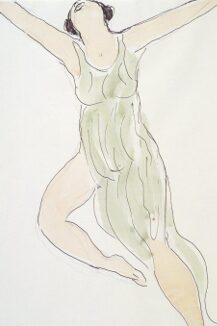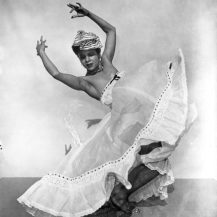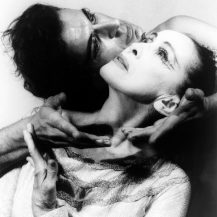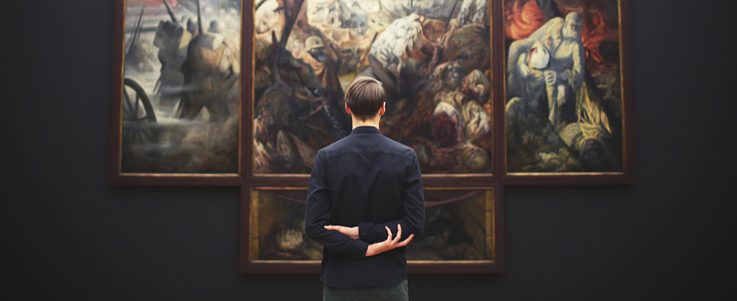As in Germany, changing sociopolitical contexts impacted American modern dance. American modern dance emerged in tandem with German modern dance in the first few decades of the twentieth century.
Not until the 1930s did American modern dance gain its national character, and during the subsequent few decades it reached its peak in popularity as modern dance became established in colleges and universities, drew broad theater-going audiences, and contributed to the Golden Age of the American musical in the years after World War II. However, this popularity did not continue after the dance boom of the 1970s. By the end of the century modern dance, now termed postmodern dance, had become an elitist form, presented mostly in New York City and on college campuses.
 Isadora Duncan, 1915 | © Abraham Walkowitz, Brooklyn Museum, Wikipedia, edited, CC0-1.0
Isadora Duncan, 1915 | © Abraham Walkowitz, Brooklyn Museum, Wikipedia, edited, CC0-1.0
From 1900 to 1930, American and German modern dance were essentially indistinguishable. Soloists like Isadora Duncan and Ruth St. Denis toured both Europe and the United States, appealing to middle-class white women who saw new possibilities for female mobility, literally and figuratively, in their performances. Many in their audience took classes themselves in the new art of movement; amateur participation was particularly strong on college and university campuses. Modern dance training was also part of broader movements in theater and film. In 1916, Ruth St. Denis and Ted Shawn founded their school Denishawn in Los Angeles, and for the next decade Denishawn trained actors for silent film as well as dancers. In 1921, Martha Graham began teaching at the Neighborhood Playhouse in Greenwich Village; not only dancers but also actors employed her methods for expressive movement.
In the 1930s, American modern dance gained its own character as artists sought to distinguish their practice from German and European precedents. From 1934 to 1939, the Bennington School of the Dance taught legions of modern dancers, many of whom established dance programs in colleges and universities. Some of the Bennington artists also participated in the leftist dance movement of the era, training union workers and performing for audiences of revolutionary workers committed to Communism. African-American artists like Katherine Dunham joined the modern dance movement during the 1930s, challenging the whiteness of the form as it had developed in the early decades of the century.
 Katherine Dunham, 1938 | © Library of Congress, Picryl, edited, CC0-1.0
The 1940s and 1950s saw a broader theater-going public attending modern dance performances, especially those by Martha Graham and Katherine Dunham. The modern dancers Helen Tamiris and Hanya Holm began choreographing Broadway musicals, where many dancers found employment. In the 1950s, the US State Department also began sending the modern dancers Martha Graham and José Limón on international tours as part of Cold War diplomacy. The postwar popularity of the form culminated in the 1960s and 1970s, when the newly established National Endowment for the Arts funded US touring of modern dance companies. The counterculture of the era was drawn to modern dance as part of the broader sexual revolution and “return to the body,” and contact improvisation became widely disseminated in the counterculture during these years.
Katherine Dunham, 1938 | © Library of Congress, Picryl, edited, CC0-1.0
The 1940s and 1950s saw a broader theater-going public attending modern dance performances, especially those by Martha Graham and Katherine Dunham. The modern dancers Helen Tamiris and Hanya Holm began choreographing Broadway musicals, where many dancers found employment. In the 1950s, the US State Department also began sending the modern dancers Martha Graham and José Limón on international tours as part of Cold War diplomacy. The postwar popularity of the form culminated in the 1960s and 1970s, when the newly established National Endowment for the Arts funded US touring of modern dance companies. The counterculture of the era was drawn to modern dance as part of the broader sexual revolution and “return to the body,” and contact improvisation became widely disseminated in the counterculture during these years.
 Martha Graham and Bertram Ross in Visionary Recital, 1961 | © Carl Van Vechten, Library of Congress, Wikipedia, edited, CC0-1.0
In the 1980s, however, modern dance lost its broader public as the Reagan era saw cuts to arts funding. Postmodern aesthetics, first evident in the choreography of Merce Cunningham and Judson Dance Theater, became dominant, and the broader theater-going public no longer showed as much interest in modern dance as it had earlier. There were exceptions: in the 1960s, Alvin Ailey infused mid-century modern dance with an African aesthetic, and his company continues to draw broad audiences today. In the early 1990s, Bill T. Jones created epic works in response to the culture wars of the time—Last Night at Uncle Tom’s Cabin/The Promised Land and Still/Here—which drew broad interest. Since then Jones has choreographed several well-received musicals, including Fela! and Spring Awakening.
Martha Graham and Bertram Ross in Visionary Recital, 1961 | © Carl Van Vechten, Library of Congress, Wikipedia, edited, CC0-1.0
In the 1980s, however, modern dance lost its broader public as the Reagan era saw cuts to arts funding. Postmodern aesthetics, first evident in the choreography of Merce Cunningham and Judson Dance Theater, became dominant, and the broader theater-going public no longer showed as much interest in modern dance as it had earlier. There were exceptions: in the 1960s, Alvin Ailey infused mid-century modern dance with an African aesthetic, and his company continues to draw broad audiences today. In the early 1990s, Bill T. Jones created epic works in response to the culture wars of the time—Last Night at Uncle Tom’s Cabin/The Promised Land and Still/Here—which drew broad interest. Since then Jones has choreographed several well-received musicals, including Fela! and Spring Awakening.
Bill T. Jones had seen Pina Bausch during her inaugural season in New York City in 1984, and her sprawling dance theater was one of many influences on his subsequent career. In the 1980s and 1990s, American modern dance began to absorb many influences from abroad – not only from German Tanztheater but also Japanese Butoh and modern dance movements from Latin America and Asia. In fact, the recent globalization of modern dance has led historians to challenge the national histories of German and American modern dance and propose a more transnational history of the movement (Manning 2019). This globalization, however, has not led to populism. NEA studies still show that audiences for modern dance are among the most educated of all arts publics.
Bibliography
Daly, Ann, Done Into Dance: Isadora Duncan in America, Indianapolis: University of Indiana Press, 1995.
Foulkes, Julia, Modern Bodies: Dance and American Modernism from Martha Graham to Alvin Ailey, Chapel Hill: University of North Carolina Press, 2002.
Jowitt, Deborah, Time and the Dancing Image, New York: William Morrow, 1988.
Manning, Susan, Modern Dance, Negro Dance: Race in Motion, Minneapolis: University of Minnesota Press, 2004.
Manning, Susan, “Dance History,” in Bloomsbury Companion to Dance Studies, ed. Sherril Dodds, London: Bloomsbury Publishing, 2019.
Perpener, John O, African American Concert Dance: the Harlem Renaissance and Beyond, Urbana: University of Illinois Press, 2001.
To the Overview
